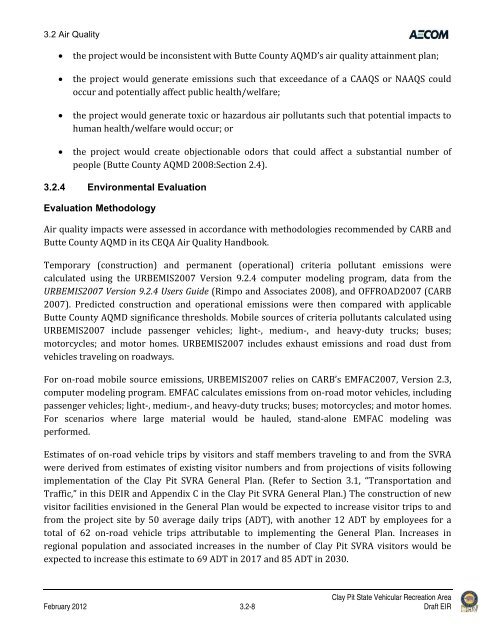Draft Environmental Impact Report - California Off Highway Vehicle ...
Draft Environmental Impact Report - California Off Highway Vehicle ...
Draft Environmental Impact Report - California Off Highway Vehicle ...
You also want an ePaper? Increase the reach of your titles
YUMPU automatically turns print PDFs into web optimized ePapers that Google loves.
3.2 Air Quality<br />
the project would be inconsistent with Butte County AQMD’s air quality attainment plan;<br />
the project would generate emissions such that exceedance of a CAAQS or NAAQS could<br />
occur and potentially affect public health/welfare;<br />
the project would generate toxic or hazardous air pollutants such that potential impacts to<br />
human health/welfare would occur; or<br />
the project would create objectionable odors that could affect a substantial number of<br />
people (Butte County AQMD 2008:Section 2.4).<br />
3.2.4 <strong>Environmental</strong> Evaluation<br />
Evaluation Methodology<br />
Air quality impacts were assessed in accordance with methodologies recommended by CARB and<br />
Butte County AQMD in its CEQA Air Quality Handbook.<br />
Temporary (construction) and permanent (operational) criteria pollutant emissions were<br />
calculated using the URBEMIS2007 Version 9.2.4 computer modeling program, data from the<br />
URBEMIS2007 Version 9.2.4 Users Guide (Rimpo and Associates 2008), and OFFROAD2007 (CARB<br />
2007). Predicted construction and operational emissions were then compared with applicable<br />
Butte County AQMD significance thresholds. Mobile sources of criteria pollutants calculated using<br />
URBEMIS2007 include passenger vehicles; light‐, medium‐, and heavy‐duty trucks; buses;<br />
motorcycles; and motor homes. URBEMIS2007 includes exhaust emissions and road dust from<br />
vehicles traveling on roadways.<br />
For on‐road mobile source emissions, URBEMIS2007 relies on CARB’s EMFAC2007, Version 2.3,<br />
computer modeling program. EMFAC calculates emissions from on‐road motor vehicles, including<br />
passenger vehicles; light‐, medium‐, and heavy‐duty trucks; buses; motorcycles; and motor homes.<br />
For scenarios where large material would be hauled, stand‐alone EMFAC modeling was<br />
performed.<br />
Estimates of on‐road vehicle trips by visitors and staff members traveling to and from the SVRA<br />
were derived from estimates of existing visitor numbers and from projections of visits following<br />
implementation of the Clay Pit SVRA General Plan. (Refer to Section 3.1, “Transportation and<br />
Traffic,” in this DEIR and Appendix C in the Clay Pit SVRA General Plan.) The construction of new<br />
visitor facilities envisioned in the General Plan would be expected to increase visitor trips to and<br />
from the project site by 50 average daily trips (ADT), with another 12 ADT by employees for a<br />
total of 62 on‐road vehicle trips attributable to implementing the General Plan. Increases in<br />
regional population and associated increases in the number of Clay Pit SVRA visitors would be<br />
expected to increase this estimate to 69 ADT in 2017 and 85 ADT in 2030.<br />
Clay Pit State Vehicular Recreation Area<br />
February 2012 3.2-8 <strong>Draft</strong> EIR








